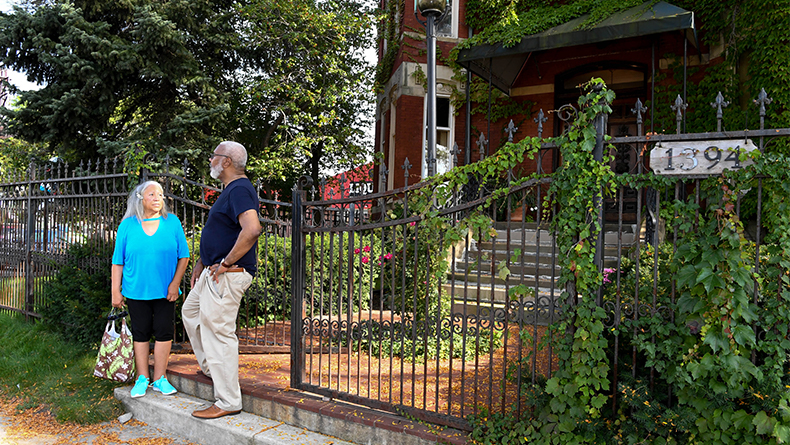AARP Hearing Center
Policies That Allow More Homebuilding Can Help Older Adults
By Timothy Murphy, Tushar Kansal, August 19, 2025 10:21 AM

More than seven-in-ten older adults would prefer to remain in their communities as they age while large majorities of those 50 and older favor a roster of zoning and land-use policies that would allow more homes to be built, according to surveys by AARP and The Pew Charitable Trusts.
The United States is aging. The share of those 65 and older increased 34% between 2012 and 2022, reaching 58 million people. By 2030, one in five Americans will be at least 65. The historic trend calls for planning and actions to address many critical societal concerns. That includes housing availability because the country is not prepared to meet the residential needs and preferences specific to this growing group.
Research by Pew and AARP helps illuminate the housing preferences and needs of older adults, highlighting potentially effective policies to help increase availability and choice for people of all ages. The Pew survey shows broad support for various land-use and zoning policy changes intended to do that, including among older Americans. Communities and states have already started to take action and find success.
Older adults face numerous housing challenges
With the growth in older households, more in the over-50 age group face rising housing costs, housing instability, and even homelessness. In 2021, data from the Harvard Joint Center for Housing Studies show that nearly 11.2 million adults 65 and older were considered burdened by housing costs because they were spending more than 30% of their income on housing — an all-time high. Homelessness among older adults is increasing as well: while those 50 and older represented 10% of the homeless population in the early 1990s, today they make up almost half. Older adults face other significant financial challenges as well, such as the increased costs of long-term care.
Multiple factors have contributed to increasing housing costs, including insufficient building, high construction costs, the resulting shortage of homes for sale or rent, and underfunded housing assistance. Zoning and land-use regulations also limit what is available, further raising rents and home sale prices. Existing planning policies often restrict more affordable housing options such as accessory dwelling units (for example, basement apartments or backyard cottages), townhouses, duplexes, apartments and condominiums, and factory-built housing. With housing stock limited, costs increase.
Meanwhile, a 2024 AARP survey shows that many older adults prefer to age in place although they often reside in homes that are not designed to support aging. Only 1% of homes have five key accessibility features: a zero-step entrance, single-story living, wide doorways and halls, lever-style handles, and electrical controls accessible from a wheelchair.
The importance of aging in place
Aging in place — that is, remaining in one’s home or community — and receiving home- and community-based services can lead to better health outcomes, increased life satisfaction, and higher self-esteem compared to living in nursing homes. It is also usually more cost effective, and what people want.
In 2024, 73% of adults age 50 and older expressed a desire to stay in their local communities in an AARP survey. Social connections, local amenities, and access to services such as doctors are vital for older adults, but all of that can be lost with a move to a new community. Fifty-six percent of older adults that responded to the AARP survey said that it is extremely or very important that their community provide a range of housing options that can fit people’s needs as they age.
Land-use and zoning reform and its broad popularity
To support aging in place and address housing costs, communities need to have a sufficient number of affordable and age-friendly homes, accessible transportation, and nearby services. The current regulatory environment and low supply of suitable homes near essential amenities too often become a barrier to that.
Changes to zoning and land-use policies that would enable more homes to be built are broadly popular, including among older adults. A national survey conducted for Pew in late 2023 found strong support among respondents age 50 and older for home-building. The survey showed that these policies enjoy widespread support across other demographic metrics as well, including geographic location, political affiliation, race and ethnicity, ownership/rental status, and income level.
Ipsos conducted the nationally representative survey of 5,051 people from Sept. 8-17, 2023, for Pew using its probability-based KnowledgePanel.
Figure 1
Strong Majorities Across Age Groups Support Policies to Allow More Housing
Share in favor of each approach
The survey showed strong overall support for the surveyed policies among respondents across ages (see Figure 1). They gave the strongest support to requiring simplified, faster permitting; allowing commercial buildings to be converted to housing; and allowing apartments near transit and job centers. On some policies, there were modest variations in strength of support. For example, respondents 65 and older expressed lower levels of support than younger respondents for allowing housing types such as accessory dwelling units and duplexes in residential neighborhoods, suggesting the possible need for outreach on potential benefits of the policies for older adults and people of all ages.
Older homeowners and renters express strong support for almost all the policies surveyed to enable more homebuilding (see Figure 2). However, renters 50 and older showed greater support than older homeowners for policies allowing more homes on blocks of single-family detached houses such as allowing accessory dwelling units, townhouses and small apartment buildings on any residential lot; and homes to be built closer together with smaller yards. That could be explained in part by the fact that older renters are more than twice as likely to struggle with housing costs compared with older homeowners. In fact, older renters possess just 2% of the median net wealth of older homeowners.
Figure 2
Older Adult Renters and Homeowners Support Policies to Allow More Homes
Share in favor of each approach
A growing track record for reforms
Some local governments and states are already changing zoning regulations to address the supply mismatch. Houston, for example, lowered its minimum lot size from 5,000 to as little as 1,400 square feet in the central city in 1998 and city-wide in 2013. That helped lead to the construction of nearly 80,000 new townhouses affordable for middle-income households. Minneapolis, meanwhile, simplified permitting for building apartments near commerce, reduced parking mandates, and allowed taller buildings downtown and near transit. These changes increased housing stock by 12% between 2017 and 2022; during that time, rents rose only 1%.
At the state level, Arizona, California, Colorado, Florida, Massachusetts, Montana, and Texas have enacted reforms that allow more duplexes and accessory dwelling units, streamline permitting processes, and allow homes to be built in commercial areas. In these states, the efforts were bipartisan, with lawmakers recognizing the need for affordable housing.
Older adults in particular can benefit from such changes. New apartments and condominiums often have entrances with no steps and are located near services and amenities. In addition, accessory dwelling units in backyards and basements, and duplexes and triplexes in residential neighborhoods, provide housing options that are smaller and easier to maintain and navigate than detached houses.
One piece of the solution
Enhancing the availability of different housing types in locations that better meet the needs of older adults is critical. But many analysts and organizations believe that this strategy must be complemented by additional approaches, such as providing subsidized housing, enhancing housing accessibility, and improving access to manufactured housing.
A crucial step to addressing the housing challenges faced by older adults is for states and local governments to reform land-use policies and zoning rules to allow more homes, of different types, to be built. By leveraging the support of both older and younger adults for these reforms, communities can expand housing options to meet the needs of all as they age.

































































